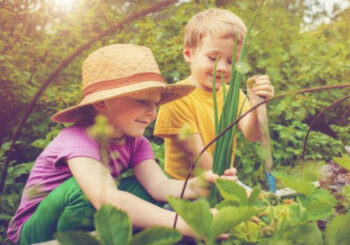By Amelia Harris
Staff Writer for Wake Up World
As the world population continues to grow, the demand for food is also increasing. However, food production and distribution have not kept pace with the growing population, which is part of the elites agenda, more on that in another article. This has led to several problems, including food insecurity, malnutrition, and environmental degradation. To address these issues, there is a need for a paradigm shift in the way we produce and consume food. One of the best ways to do this is by teaching children to grow their own food.
Benefits of Teaching Children to Grow Their Own Food
Teaching children to grow their own food offers several benefits, including improved health and nutrition, physical activity, environmental sustainability, and a sense of responsibility.
1. Improves Health and Nutrition
When children learn to grow their own food, they are more likely to eat fresh fruits and vegetables. This can lead to improved health and nutrition as these foods are rich in essential vitamins, minerals, and fiber. Moreover, growing their own food can help children develop healthy eating habits that can last a lifetime.
In contrast, many children in urban areas lack access to fresh fruits and vegetables, which can lead to poor health outcomes. According to the Centers for Disease Control and Prevention (CDC), only 9% of high school students in the United States consume the recommended daily amount of fruits and vegetables. This can contribute to several health problems, including obesity, diabetes, and heart disease.
Teaching children to grow their own food can also help address food deserts, which are areas where residents lack access to fresh and healthy food. By growing their own food, children can become more self-sufficient and less reliant on grocery stores, which may not always carry fresh produce.
2. Encourages Physical Activity
Growing food requires physical activity, such as digging, planting, weeding, and harvesting. These activities can help children stay active and healthy, reducing their risk of obesity and related health problems. Moreover, physical activity has been linked to improved mental health outcomes, such as reduced stress and anxiety.
In contrast, many children in the United States do not meet the recommended guidelines for physical activity. According to the CDC, only 26% of high school students engage in at least 60 minutes of physical activity per day. This can contribute to several health problems, including obesity, diabetes, and heart disease.
Teaching children to grow their own food can also help them understand the connection between physical activity and health. They can learn that being active is not just about playing sports, but also about engaging in activities that promote health and well-being.
3. Promotes Environmental Sustainability
Teaching children to grow their own food can also help promote environmental sustainability. When children learn about the importance of composting, reducing waste, and using organic methods, they can develop a deep respect for the environment. Moreover, growing food locally can reduce the carbon footprint associated with transportation and storage.
In contrast, traditional farming methods can have a negative impact on the environment. Conventional agriculture often relies on synthetic fertilizers and pesticides, which can pollute soil and water. Moreover, large-scale farming can contribute to deforestation, biodiversity loss, and climate change.
Teaching children to grow their own food can help promote sustainable and regenerative farming practices. They can learn about the importance of soil health, crop rotation, and integrated pest management. Moreover, they can become advocates for sustainable agriculture and environmental conservation.
4. Fosters a Sense of Responsibility
Growing food requires commitment and responsibility. Children learn that they have to take care of the plants, water them regularly, and protect them from pests and diseases. These skills can translate to other areas of their lives, such as taking care of pets or being responsible citizens in their communities.
Moreover, growing their own food can give children a sense of ownership and pride. They can see the fruits of their labor and feel a sense of accomplishment when they harvest their crops. This can help boost their self-esteem and confidence.
How Teaching Children to Grow Their Own Food Can Change the World
Teaching children to grow their own food can have a ripple effect on society and the world. Here are some ways it can make a difference:
1. Improved Health and Nutrition
When children learn to grow their own food, they are more likely to eat fresh fruits and vegetables, which can lead to improved health and nutrition. This can reduce the incidence of diet-related diseases, such as obesity, diabetes, and heart disease.
Moreover, by growing their own food, children can become more aware of where their food comes from and how it is produced. This can lead to a greater appreciation for healthy and sustainable food choices.
2. Sustainable Agriculture
Teaching children to grow their own food can promote sustainable and regenerative agriculture practices. They can learn about composting, reducing waste, using organic methods, and growing food locally. These practices can help reduce the carbon footprint associated with conventional agriculture and promote biodiversity and soil health.
Moreover, by becoming advocates for sustainable agriculture, children can influence their families, friends, and communities to adopt more environmentally friendly practices.
3. Food Security
Teaching children to grow their own food can also help address food insecurity. By becoming more self-sufficient and less reliant on grocery stores, children can help ensure that their families have access to fresh and healthy food.
Moreover, by sharing their surplus produce with their neighbors and community, children can contribute to local food systems and promote food security for all.
4. Empowerment
Teaching children to grow their own food can empower them to take control of their health, nutrition, and environment. By learning practical skills and knowledge, they can become more confident and self-reliant. Moreover, by becoming advocates for sustainable agriculture, they can influence positive change in their communities and the world.
Teaching children to grow their own food can have a transformative effect on their health, nutrition, environment, and sense of responsibility. By becoming advocates for sustainable agriculture, they can influence positive change in their communities and the world. If we want to change the world, we must start by empowering our children to grow their own food.
References:
- Johnson, C., & Kuhar, T. (2018). The Benefits of Gardening for Children: A Systematic Review of Current Literature. Journal of Therapeutic Horticulture, 28(1), 42-51.
- Palmer, S. (2019). Why Children Need to Learn to Grow Their Own Food. The Guardian. Retrieved from https://www.theguardian.com/lifeandstyle/2019/feb/24/why-children-need-to-learn-to-grow-their-own-food
- Pollan, M. (2009). The Omnivore’s Dilemma: A Natural History of Four Meals. New York: Penguin Press.
- Savio, G. (2019). Teaching Sustainable Agriculture to Children: Impacting the Future of the Planet. Frontiers in Sustainable Food Systems, 3, 36.
- Sivonen, K., & Rantala, O. (2017). Empowering Children Through Gardening. Childhood Education, 93(2), 136-142.
- Williams, C. (2017). Children Who Garden Grow up to Eat their Vegetables. The Conversation. Retrieved from https://theconversation.com/children-who-garden-grow-up-to-eat-their-vegetables-81878
About the author:
Amelia Harris is a writer and eco-activist, interested in health and all things esoteric, with a passion for sharing good news and inspiring stories. She is a staff writer for Wake Up World.

If you've ever found value in our articles, we'd greatly appreciate your support by purchasing Mindful Meditation Techniques for Kids - A Practical Guide for Adults to Empower Kids with the Gift of Inner Peace and Resilience for Life.
In the spirit of mindfulness, we encourage you to choose the paperback version. Delve into its pages away from screen glare and notifications, allowing yourself to fully immerse in the transformative practices within. The physical book enriches the learning process and serves as a tangible commitment to mindfulness, easily shared among family and friends.
Over the past few years, Wake Up World has faced significant online censorship, impacting our financial ability to stay online. Instead of soliciting donations, we're exploring win-win solutions with our readers to remain financially viable. Moving into book publishing, we hope to secure ongoing funds to continue our mission. With over 8,500 articles published in the past 13 years, we are committed to keeping our content free and accessible to everyone, without resorting to a paywall.








